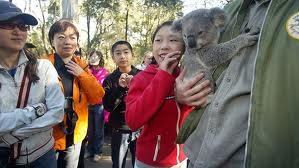
Since Deng Xiaoping reopened China for global trade in the late 1970s we have witnessed China’s transformation into the world’s second largest economy. For a number of years Australia has prospered from China’s overwhelming need for resources, especially iron ore and coal. Now we are set to see a new era with the emergence of China’s new wealthy and expanding middle-class ready to embrace foreign experiences and products. Australian universities are already prospering from the enrolments of huge numbers of Asian students many from mainland China (DFAT 2013). Other industries can do well too, with a greater level of cultural awareness.
Australia’s many spectacular tourist attractions such as the Great Barrier Reef and Uluru offer the perfect environment to lure China’s upwardly mobile visitors. Last year The Australian newspaper reported that over the past 10 years Chinese visitor numbers to Australia have tripled (Saurine 2013). However, this would seem to be just the tip of the iceberg especially when we take into account that:
Given how much there is to gain from Chinese visitors it is important to explore cultural differences, to achieve greater cultural awareness and understand what we might need to do differently to remain competitive and desirable in this market.
It is vital that Australian tourist attractions bridge the language gap by providing Chinese Mandarin speakers. There are hundreds of dialects spoken in China, and Mandarin is often the tourists’ second or third language; however, it is a common language and many Chinese find it much easier to communicate in than English.
Seawalker is a highly successful water sports operator on Australia’s Great Barrier Reef. The company gives an introduction to the underwater world by enabling its customers to don a diving helmet with surface air attached, and walk on the seabed. This eliminates the need to be able to swim or have a level of water skill competency. By providing a unique, safe and simple way of enabling visitors to be part of the underwater world, Seawalker perfectly meets the needs of mainland Chinese visitors who have limited water confidence.
White water rafting is another activity that is popular, although in China it is organised very differently: Smaller rapids provide the setting, and people sit in the rafts and enjoy the ride with no paddling required. This is vastly different from the way we undertake white water rafting in Australia (Buckley 2014) Australian companies who are culturally aware, and take on board the differences will be set to reap the rewards of tailoring their service particularly to Asian customers.
An Australian tour operator in the Blue Mountains once told me that one of her Japanese tourists’ favourite attraction had not been the sighting of a rainbow. Considering the three sisters, the cable car and the quant charm of the Blue Mountains, this surprised the tour operator, but nevertheless the bus was stopped so that the entire group could take photos. Many of them said this had been the first time they had ever seen a rainbow.
There are also famous stories about how much Chinese tourists enjoy our wide, open blue skies. Other who say that while Sydney is no match for their modern and sophisticated cities such as Beijing and Shanghai, however, they marvel at our clean air and wonderful nature.
It’s interesting that the old stereotype about wealthy Asian tourists is that they want to shop. Let’s not forget this is a global village we live and most of the products available in Australia have origintated from their country in the first place. We need to think differently. We need to embrace diversity and we need to develop greater cultural awareness.
Our next blog will look at further areas that can assist Australia in attracting and satisfying Chinese tourists but for now we would like to leave our readers with two final comments:
One of the most exciting aspects in the growth in Chinese tourism is that, unlike the resource boom that employs less than 2% of Australia’s workforce (Waters 2011), a far larger number of Australian industries and people will be able to benefit, especially if they embrace the need to be flexible and adapt the different needs of their new visitors.
Waters, L. (2011). “Australia’s mining boom: fact or fiction.” Retrieved 27 Aug, 2014, from http://www.abc.net.au/news/2011-09-08/waters-australias-mining-boom-fact-or-fiction/2876728.
UNWTO (2013). “World’s Top Tourism Spenders.” Retrieved 27 Aug, 2014, from http://dtxtq4w60xqpw.cloudfront.net/sites/all/files/pdf/tsen_0.pdf?_ga=1.155285051.1835702783.1409107228.
Saurine, A. (2013). “Chinese tourists to Australia triple in a decade as visitors rise.” Retrieved 27 Aug 2014, from http://www.theaustralian.com.au/travel/news/chinese-tourists-to-australia-triple-in-a-decade-as-visitors-rise/story-e6frg8ro-1226571914405.
Kohler, A. (2014). “Time to roll out the red carpet “. Retrieved 27 Aug, 2014, from http://www.theaustralian.com.au/business/opinion/time-to-roll-out-the-red-carpet/story-fng7vg0p-1227020995881.
DFAT (2013). “Australia’s trade in goods and services 2013.” Retrieved 26 August 2014, 2014, from http://dfat.gov.au/publications/tgs/index.html.
Cai, P. (2014). “Independent Chinese travellers hold the key to Australia’s tourism market.” Retrieved 27 Aug, 2014, from https://www.businessspectator.com.au/article/2014/8/26/tourism/independent-chinese-travellers-hold-key-australias-tourism-market.
Buckley, R. (2014). “Ecotourism for the Chinese: up the creek without a paddle.” Retrieved 27 Aug, 2014, from http://theconversation.com/ecotourism-for-the-chinese-up-the-creek-without-a-paddle-25815.
Browne, A. (2014). “Long march out of China.” Retrieved 27 Aug 2014, from http://www.theaustralian.com.au/business/wall-street-journal/long-march-out-of-china/story-fnay3ubk-1227028502411.